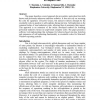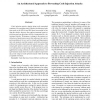46 search results - page 3 / 10 » Preventing Pollution Attacks in Multi-source Network Coding |
MMMACNS
2005
Springer
13 years 10 months ago
2005
Springer
This paper describes a novel approach for preventative protection from both known and previously unknown malicious software. It does not rely on screening the code for signatures ...
DSN
2007
IEEE
13 years 11 months ago
2007
IEEE
Code injection attacks, despite being well researched, continue to be a problem today. Modern architectural solutions such as the NX-bit and PaX have been useful in limiting the a...
INFOCOM
2010
IEEE
13 years 3 months ago
2010
IEEE
Network coding has been shown to be capable of greatly improving quality of service in P2P live streaming systems (e.g., IPTV). However, network coding is vulnerable to pollution a...
ACSAC
2010
IEEE
13 years 3 months ago
2010
IEEE
The JavaScript language is a core component of active and dynamic web content in the Internet today. Besides its great success in enhancing web applications, however, JavaScript p...
INFOCOM
2009
IEEE
13 years 12 months ago
2009
IEEE
—The performance of randomized network coding can suffer significantly when malicious nodes corrupt the content of the exchanged blocks. Previous work have introduced error corr...


